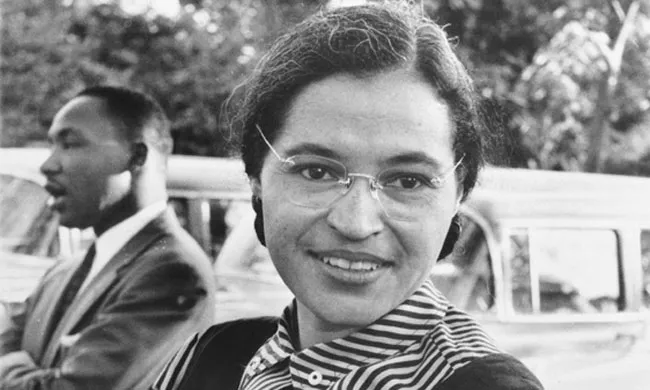Rosa Parks is an incredibly important person in the history of civil rights and racial equality. She helped start the Civil Rights Movement in the United States of America when she refused to give up her bus seat for a white male passenger in Montgomery, Alabama in 1955.
Her actions eventually led to the U.S. Supreme Court ruling that segregation on public buses is unconstitutional.
Let’s take a look at the Top 10 Facts about Rosa Parks.

1. Rosa Parks was born on 4th February 1913 in Tuskegee, Alabama.
Rosa Parks was born on 4th February 1913 in Tuskegee, Alabama. She would later move to Montgomery, Alabama with her mother and sister, Sylvester.
2. She was an African American civil rights activist, best known for her refusal to give up her seat on a Montgomery, Alabama bus in 1955.
Rosa Parks was an African American civil rights activist whose refusal to give up her seat on a Montgomery, Alabama bus in 1955 sparked a nationwide boycott and helped launch the civil rights movement in the United States.
Her brave act of civil disobedience and refusal to accept racial segregation made her an iconic figure in the history of the civil rights movement and a symbol of courage and strength. Despite her arrest and the backlash she experienced, Parks continued to be a champion of civil rights, advocating for equal rights and justice until her death in 2005.

3. Following her famous bus protest, she was arrested, convicted, and fined $14.
Rosa Parks’ refusal to give up her seat on a segregated Montgomery, Alabama, bus in 1955 sparked a year-long boycott of the city’s public transportation system. Her arrest for breaking a local law sparked a series of events that eventually led to the desegregation of public buses. As a result of her act of civil disobedience, Parks was arrested, convicted and fined $14.
4. In 1996, she was awarded the Presidential Medal of Freedom by President Clinton.
In 1996, Rosa Parks was awarded the highest honour given to civilians in the United States, the Presidential Medal of Freedom, by President Bill Clinton. The award is given to those individuals who have made especially meritorious contributions to the security or national interests of the United States, to world peace, or to cultural or other significant public or private endeavours. Parks was chosen for her significant contribution to the civil rights movement, and her refusal to give up her seat on a segregated bus to a white passenger in 1955. The award was a recognition of her bravery and her dedication to civil rights.

5. She was also awarded the Congressional Gold Medal in 1999.
Rosa Parks was honoured for her efforts in the civil rights movement with the Congressional Gold Medal, the highest civilian award given by the United States Congress. The medal was presented to Parks in recognition of her bravery and her commitment to justice and equality.
6. She was a seamstress by trade.
Rosa Parks was an important civil rights activist, but she was also a seamstress by trade. She worked as a seamstress for much of her life, including while she was living in Montgomery, Alabama and was an active member of the civil rights movement.
Her seamstress skills allowed her to provide for her family and also to create clothing for those in the movement who needed it. Parks’ work as a seamstress is an important part of her legacy, as it was her way of contributing to the cause and providing for her family.

7. In 2005, a new species of spider was named after Rosa Parks, Aptostichus rosaparksae.
The spider, Aptostichus rosaparksae, was named after Rosa Parks in 2005 to recognise her contribution to the civil rights movement.
8. She wrote an autobiography, “Rosa Parks: My Story”, which was published in 1992.
Rosa Parks wrote an autobiography titled “Rosa Parks: My Story” which was published in 1992. This book was a detailed account of her life and the events that led to her arrest in 1955, when she refused to give up her bus seat to a white passenger.
It was a powerful and inspiring story that highlighted her courage and determination in the face of racial injustice. The book was a national bestseller in the USA.

9. She was a lifelong advocate for civil rights, and continued to work for civil rights organisations until her death in 2005.
Even after her famous arrest, Rosa continued to work for civil rights organisations, speaking out against racism and discrimination. Her legacy as a civil rights leader and champion of social justice will never be forgotten, and she continued to fight for civil rights until her death in 2005.
10. There is a statue of Rosa Parks!
This bronze statue is located in the Capitol Rotunda in Washington D.C. and stands as a tribute to civil rights icon, Rosa Parks. The statue features the civil rights leader in a seated position and is the first full-size statue of a real woman to be placed in the Capitol.
It is a reminder of her legacy and her incredible courage that inspired the civil rights movement.

Send us your favourite facts!
Is there something we've missed? Got a fact you're dying to tell us? Submit it below and we could use it on a future Top 10 Facts page!
Remember to always ask an adult before filling out forms online.



